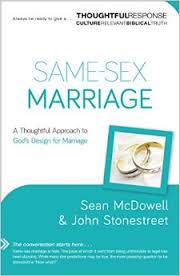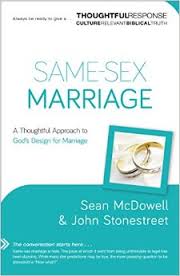 Sean McDowell and John Stonestreet, Same-Sex Marriage: A Thoughtful Approach to God’s Design for Marriage (Grand Rapids, MI: Baker Books, 2014). Paperback / Kindle
Sean McDowell and John Stonestreet, Same-Sex Marriage: A Thoughtful Approach to God’s Design for Marriage (Grand Rapids, MI: Baker Books, 2014). Paperback / Kindle
On September 21, 1996, President Bill Clinton signed the Defense of Marriage Act (DOMA) into law, which Congress had passed with overwhelming bipartisan majorities (85–14 in the Senate, 342–67 in the House). Section 3 of that law provided a legal definition of the words marriage and spouse for federal laws and regulations: “the word ‘marriage’ means only a legal union between one man and one woman as husband and wife, and the word ‘spouse’ refers only to a person of the opposite sex who is a husband or a wife.” On June 26, 2013, the Supreme Court ruled Section 3 unconstitutional by a 5–4 vote. And although DOMA was enacted with significant Democratic congressional support and signed into law by a Democratic president, the current Democratic party platform explicitly endorses “marriage equality.”
The enactment and demise of Section 3 of DOMA illustrate the tectonic shift in U.S. public opinion regarding same-sex marriage particularly and homosexuality generally. Over the past two decades, public opinion has become increasingly favorable to both. The Pew Research Center has tracked public opinion on these matters since 2001. Its polling data show a reversal of fortunes for the anti- and pro-same-sex marriage positions. In 2001, the public opposed same-sex marriage, 57–35 percent. Now it favors same-sex marriage 52–40 percent. Furthermore, the trend line of opinion regarding same-sex marriage is increasingly favorable in every demographic category: generation, religious affiliation, political party, political ideology, race, and gender.
This tectonic shift in U.S. public opinion and law is dispiriting to those of us Christians who affirm the biblical and traditional understanding of marriage as the lifelong union of one man and one woman. Given the way this understanding has shaped marriage law in America, the rapid shift of opinion represents more than political or legal defeat. It represents a cultural defeat as well.
“In light of this reality,” Sean McDowell and John Stonestreet write in their new book, “Christians should shift their mindset from preserving or conserving to proposing and building. Christians should no longer wish for a massive judicial or political victory to save marriage. When an institution has been culturally compromised the way marriage has been, it cannot be saved. It has to be redefined and reestablished” (pp. 86–87, emphasis in original).
McDowell and Stonestreet divide their book into two parts. Part 1, “What Marriage Is and Why It Matters,” offers biblical and prudential arguments for understanding marriage as the lifelong union of a man and a woman. Their biblical case focuses on the Genesis creation accounts (Genesis 1–2), which Jesus affirmed as normative for believers in Matthew 19. They identify three “essential characteristics” of marriage: (1) union, (2) procreation, and (3) permanence. Interestingly, they don’t discuss the biblical passages that proscribe homosexual behavior. This is the right move, in my opinion, because marriage can be positively defined without reference to proscribed sexual behaviors.
McDowell and Stonestreet’s prudential case builds on an argument made by Maggie Gallagher: “Sex makes babies. Society needs babies. Babies deserve mothers and fathers” (p. 44). As they explain it, “societies have a vested interest in the process that most often produces children. That’s why every society cares about sex. Societies also have a vested interest in supporting an environment that best rears children. That’s why every society cares about marriage” (p. 45).
If the traditional view of marriage acknowledges the essential connection between sex, procreation, and marriage, the revisionist view of marriage denies it. As same-sex marriage proponent E. J. Graff puts it, “Allowing two people of the same-sex to marry shifts the institution’s message… If same-sex marriage becomes legal, that venerable institution will ever stand for sexual choice, for cutting the link between sex and diapers.” Similarly, Andrew Sullivan writes, “From being a means to bring up children, [marriage] has become primarily a way in which two adults affirm their emotional commitment to one another” (p. 60).
Stated this way, readers should be able to see that the revisionist view predates advocacy of same-sex marriage by many decades. Long before gay activists began to champion same-sex marriage, advocates of the so-called “sexual revolution” were advocating changes to opposite-sex marriage, emphasizing sexual choice and emotional commitment, while simultaneously untying the knot of marriage, sex, and procreation. The results of that emphasis are all around us: sex outside of marriage, widespread use of contraceptives and abortifacients, the prevalence of nonmarital childbirth, no-fault divorce, etc. Same-sex marriage is the fruit of the sexual revolution, then, but not the root of it.
Part 2, “What We Can Do for Marriage,” offers practical suggestions for how the Christian church can go about rebuilding a culture of marriage in America. To me, the most interesting suggestion is the authors’ call to repentance in chapter 9. “If, in response, we spend the next 20 years point out discrimination and lost religious freedoms to the world without addressing concerns in our own community, we will become our own worst enemies. It’s time to take a long, hard look inward, admit our shortcomings and ask forgiveness from God, from each other and, where appropriate, from the gay community. There is no path forward to building a strong marriage culture that does not begin with a revival of God’s people to His design for marriage” (p. 100, emphasis in original).
That revival means we must address the practices of nonmarital sex, cohabitation, and nonmarital childbirth within the Christian community, not to mention of divorce. It also means that we need to address unbiblical attitudes and actions toward homosexual people. What might those be? McDowell and Stonestreet provide a list of questions:
- Have we told inappropriate jokes that dehumanize gays and lesbians?
- Have we treated some persons differently because of what we knew or suspected about their sexual orientation?
- Have we listened as someone entrusted us with his or her deep struggles and sexual identity or behaviors, only to break off the relationship in disgust and fear?
- Have we slandered others, whether or not they’ve slandered us first?
- Have we spread gossip?
- Have we condemned another, using their homosexual sin to justify and coddle our own heterosexual sin?
- Have we re-tweeted or re-posted harsh and uncharitable words about the gay community on Facebook?
- Have we physically or emotionally abused someone because they identify as gay? (p. 106)
McDowell and Stonestreet offer many other suggestions for building a culture of marriage in the United States, but their emphasis on repentance is both welcome and the best place to start. Didn’t Jesus himself say, “Why do you look at the speck of sawdust in your brother’s eye and pay no attention to the plank in your own eye? How can you say to your brother, ‘Let me take the speck out of your eye,’ when all the time there is a plank in your own eye? You hypocrite, first take the plank out of your own eye, and then you will see clearly to remove the speck from your brother’s eye” (Matthew 7:3–5)?
Same-Sex Marriage is a short book, written to persuade the average Christian and thus ideal for use in Sunday school classes, small groups, and book clubs. Its tone is consistently gracious. It touches on the main points of the argument about the nature of marriage without getting bogged down in details. A short list of books for further reading would’ve been helpful, though readers who want to study the topic at greater length can mine the endnotes for that information.
P.S. If you found my review helpful, please vote yes on my Amazon.com review page.


One thought on “Review of ‘Same-Sex Marriage’ by Sean McDowell and John Stonestreet”